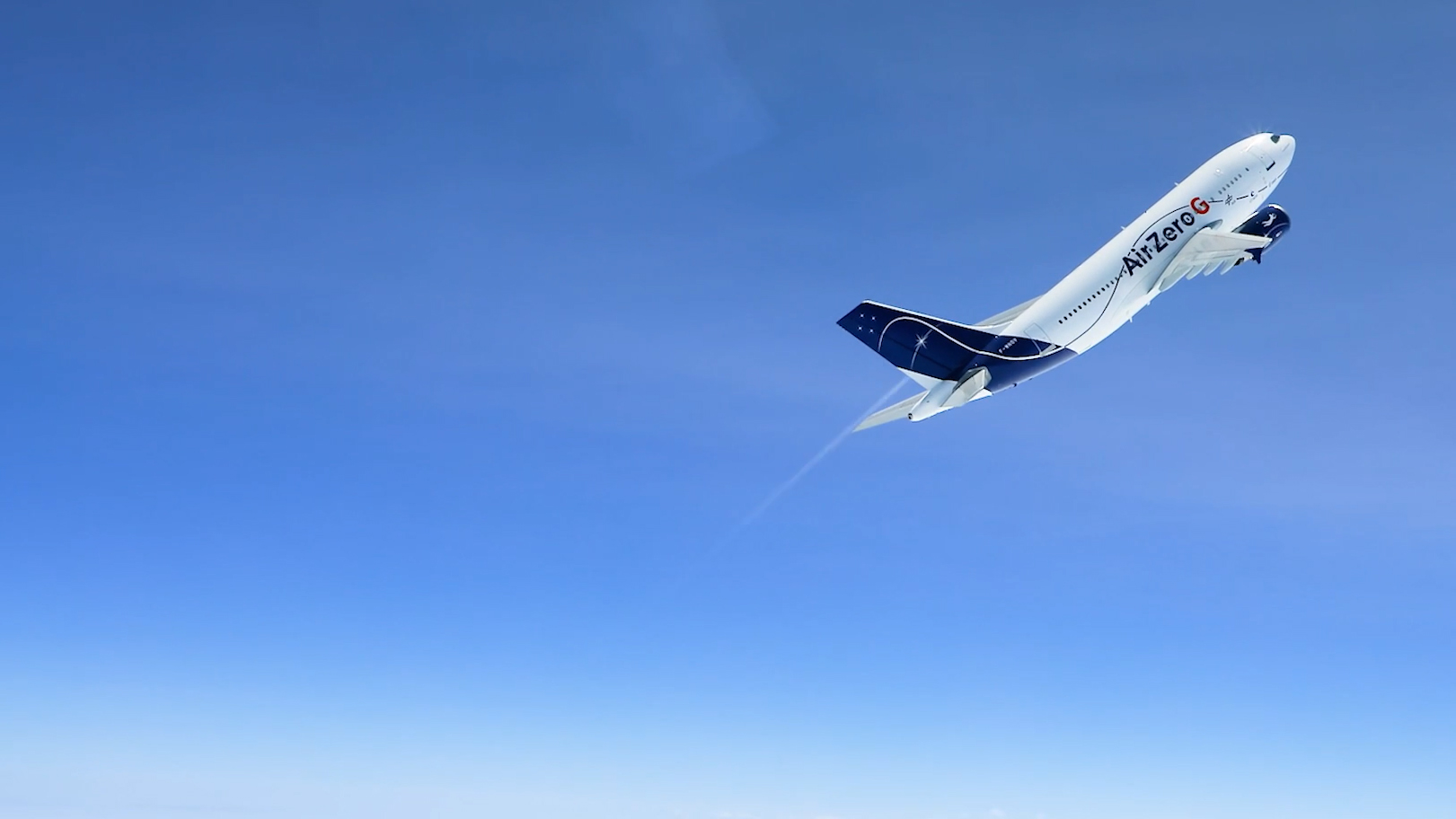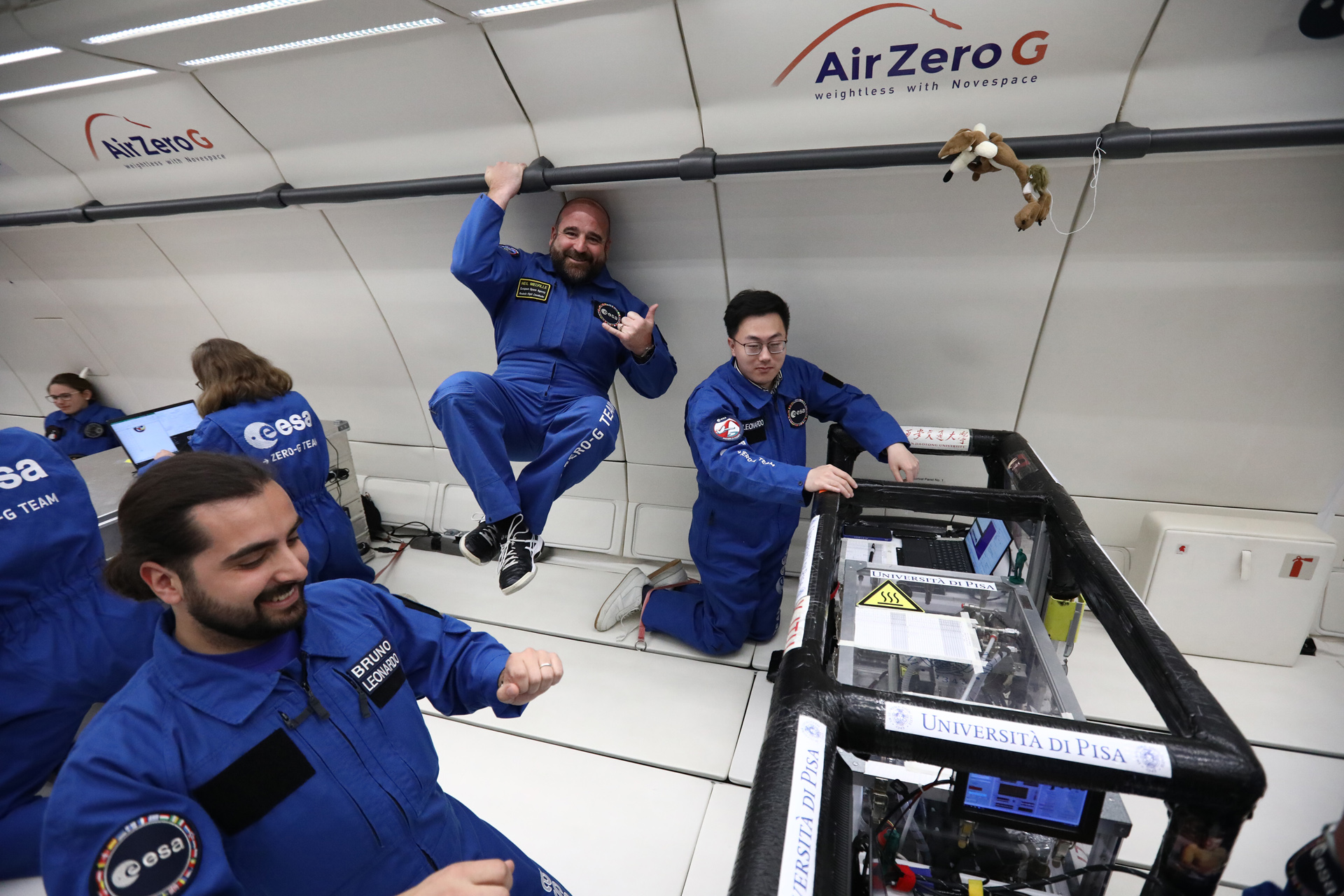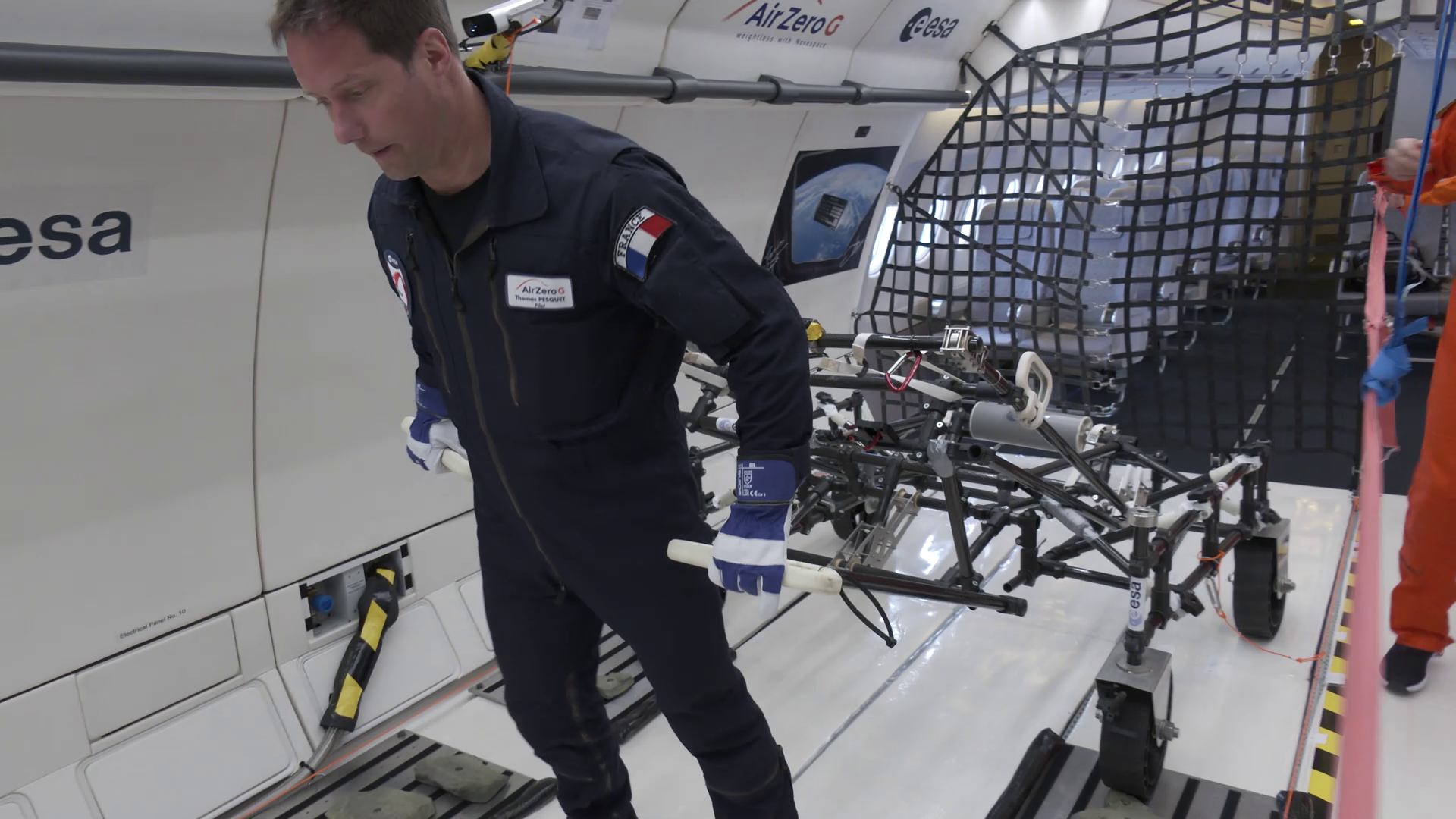Watch scientists turn an aircraft into a moon gravity research lab (video)
Parabolic flights are the only way to create lunar gravity conditions on Earth.
European scientists are turning an aircraft into a laboratory that simulates lunar gravity to prepare astronauts and technology for future moon landings as part of the NASA-led Artemis missions.
The moon is a strange little world. Only about 1.2% the mass of Earth, our planet's companion exerts a much weaker gravitational force on objects on its surface than its parent planet. As a result, an astronaut on the moon's surface feels as if he or she only weighs one sixth of their earthly weight. The same goes for all equipment the astronauts would use. It may sound like no big deal, but this feeble gravitational pull creates all sorts of unforeseen problems that are difficult to prepare for in research labs on Earth. There is, however, one way to experience lunar gravity while still in the confines of Earth and explore these challenges before going to the moon: On a parabolic flight.
Parabolic flights, better known for generating weightlessness, are frequently used to prepare astronauts for missions to the International Space Station. But in April this year, the European Space Agency (ESA) ran its first parabolic flight campaign focused solely on simulating lunar and Martian gravity. Researchers from all over Europe descended upon the French city of Bordeaux, the base of French company Novespace, Europe's only provider of parabolic flights for scientific purposes, and filled the company's converted Airbus' A310 with all sorts of experiments and technology demonstrations.
During that April test campaign, the plane rose to the sky three times to conduct three-hour roller-coaster flights, each involving 31 carefully executed parabolic maneuvers. During these maneuvers, pilots first climb with the plane at maximum speed at a 50-degree angle, then pull back the throttle to allow the plane to glide over the crest of the parabola in freefall. The plane then exits the parabola and enters a brief period of steady flight.
During the climb and the subsequent exit maneuver, objects and passengers inside the plane experience nearly double the force of Earth's gravity for about 20 seconds. During the freefall, they enjoy a little under half a minute of weightlessness or reduced gravity, depending on how the pilots execute the maneuver. These brief reduced gravity spells are all researchers can get to prepare for a challenging adventure that will take humans some 240,000 miles (385,000 kilometers) away from Earth. And there is a lot to prepare for.
"On the moon, there is still gravity but it's very low," Jean Francois Clervoy, Novespace founder and retired French astronaut, who in 1999 flew to the Hubble Space Telescope, told Space.com. "So because the gravity is light, you have to rethink the way in which you design mechanisms, whether it is moving a rover or all the hardware that will be used on the moon including space suits."
Breaking space news, the latest updates on rocket launches, skywatching events and more!

For example, astronauts on the moon can't walk like people do on Earth. In footage filmed during the 1970s Apollo landings, astronauts famously hop around like kangaroos. Thus, during the flight campaign in April, an ESA team tested how a hopping astronaut could control a simple device designed to transport equipment on the moon. The device, called LESA for Lunar Equipment Support Assembly, had previously been used in an underwater simulation. The April flight campaign, however, was LESA's first ride in lunar gravity.
"We want to test how an astronaut in lunar gravity will walk with [lunar] locomotion and pull or push this kind of equipment," Hervé Stevenin, the chief instructor of European astronauts, told Space.com. "We want to see how the equipment will react on uneven terrain in lunar gravity and how difficult it would be to control it."
The researchers therefore attached rocks to the floor of the Novespace plane's spacious padded cabin to create a miniature obstacle course over which they pushed and pulled LESA during the reduced gravity spells.
Stevenin has bold visions for the Novespace plane and its role in preparing astronauts for the coming era of moon exploration. During the April test campaign, he and his colleagues experimented with virtual reality, placing test subjects into a life-like simulation of the lunar surface through a virtual reality headset. The test subjects had to perform simple tasks during the lunar gravity spells, feeling just like they would on the real moon.

Since this was the first such campaign, the tasks involved were rather simple, such as moving a box of tools from point A to point B that the test subject could see in the headset, but which was also physically present in front of him or her. In the future, the virtual reality set-up could grow more complicated and the tasks more complex.
"With this headset, the resolution is so high that it feels like being on the moon," said Stevenin. "Now when in addition to what you are trying to grasp in the virtual environment you add partial gravity, you really move like if you are on the moon. You are really embedded into [the lunar environment] and we are hoping that there is high potential for astronaut training in the future combining these two technologies."
Many of the experiments onboard the plane during the April campaign focused on human health and performance in reduced gravity. Scientists know a lot about what weightlessness does to the human body thanks to years of research on the International Space Station. They know, however, very little about what happens in lunar gravity or the gravity of Mars.
"We know only very little about the effect of lunar gravity on the human being since people were on the moon for only a very limited period of time," Alexander Chouker, a professor of medicine and academic director at the Ludwig Maximilians University in Munich, Germany, told Space.com. "And there is an additional problem because we can't simulate lunar gravity on Earth so easily."

On Earth, space physiology researchers regularly conduct bed-rest studies, during which groups of volunteers spend days or even weeks just lying in bed. Their muscles and bones quickly weaken from disuse, just as they would in weightlessness. But scientists need to know whether the low gravity of the moon would be enough to offset such physical deterioration.
"Bed rest studies can simulate microgravity but no one really knows what is the right condition to simulate lunar gravity or the gravity of Mars," said Chouker. "We are still in a sort of a black box where we don't know what the human being will be faced with and how it will cope with these conditions on the moon when they stay for more than a few days."
While the longest of the Apollo-era landings lasted a little over three days, future Artemis missions may see astronauts staying on the moon's surface for up to one month.
During the April test campaign, Chouker and his team flew an experiment containing human immune cells, hoping to learn whether the human immune system would be equally impaired in lunar gravity as it appears to be in zero gravity. From previous experiments, the researchers know that immune cells struggle to reach the infection site, making astronauts prone to illness. This struggle is caused by the cells inability to attach to the wall of the vessel that carries them.

"We have seen in the experimental setting that when there is no gravity at all, we have a centralization of the cell flow in the middle of the flow chamber, so [the cells] move faster and it's centralized, so to get in contact with a vessel wall might be difficult," Dominique Moser, a biologist at the Department of Anaesthesiology at the University of Munich Hospital, told Space.com. "Now we are investigating this issue in lunar and Martian gravity."
Another team flew a 3D printer designed to manufacture simple tools from a mixture of lunar dust and a standard 3D printing plastic. Just like LESA, this device, too, performed in lunar gravity for the first time, and the researchers are now evaluating how lunar gravity would affect the 3D printing process.
The Artemis program expects to land humans on the moon in 2025. By the end of this decade, NASA plans to build a permanent base camp near the lunar south pole that will host regular visits from Earth. Before that happens, the Novespace parabolic flight airplane is likely to rise to the sky many times to help scientists and astronauts to better prepare for the 21st century's greatest adventure.

Tereza is a London-based science and technology journalist, aspiring fiction writer and amateur gymnast. Originally from Prague, the Czech Republic, she spent the first seven years of her career working as a reporter, script-writer and presenter for various TV programmes of the Czech Public Service Television. She later took a career break to pursue further education and added a Master's in Science from the International Space University, France, to her Bachelor's in Journalism and Master's in Cultural Anthropology from Prague's Charles University. She worked as a reporter at the Engineering and Technology magazine, freelanced for a range of publications including Live Science, Space.com, Professional Engineering, Via Satellite and Space News and served as a maternity cover science editor at the European Space Agency.

